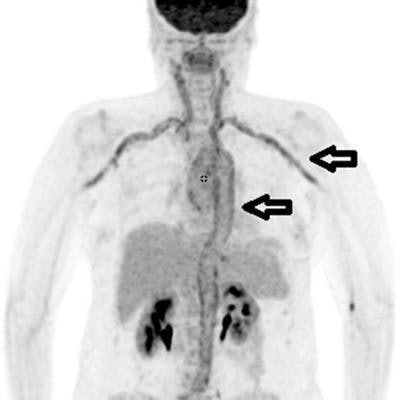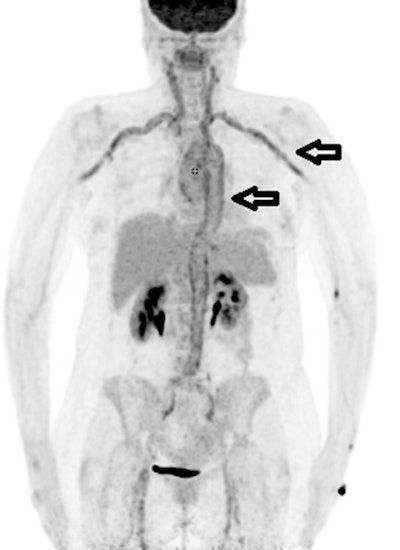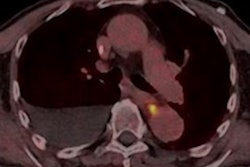
F-18 FDG PET/CT is effective for diagnosing fevers of unknown origin in more than half of cases after other imaging approaches have failed, according to a study published on 3 February in Scientific Reports.
Austrian researchers analyzed the use of F-18 FDG PET/CT in patients who presented with fevers of unknown origin yet who remained undiagnosed despite other significant diagnostic efforts. They found F-18 FDG-PET/CT diagnosed causes in more than 50% of cases after other modalities failed, including chest x-ray, CT, MRI, and sonography.
"Due to the high sensitivity of detecting early metabolic changes, F-18 FDG PET/CT represents the modality of choice in clinical management especially when other imaging modalities deliver inconclusive results," wrote corresponding author Dr. Friedrich Weitzer of the Medical University of Graz.
The results support a growing body of evidence that suggests F-18 FDG PET/CT could become a first-line tool in the workup of these patients, the authors wrote.
Fever of unknown origin in adults is defined as a temperature higher than 38.3° C that lasts for more than three weeks with no obvious source. Initial diagnostic approaches typically involve patient history, physical examination, and extensive laboratory tests. Based on these clinical signs and symptoms, imaging studies are performed.
However, nuclear medicine studies are often a last resort when findings from radiography, ultrasound, CT, MRI imaging of the chest, abdomen, pelvis, or extremities are negative in identifying the source of the fever.
As early as 2007, F-18 FDG-PET/CT has been recommended for diagnosing fever of unknown origin, yet a lack of evidence in large groups of patients over long periods remains an obstacle to its use, according to the authors.
In this study, the Austrian researchers examine the clinical value of F-18 FDG PET/CT and its impact on patient management in a large group of patients with outcomes over a five-year period.
The group retrospectively enrolled 300 men and women over the age of 18 who underwent F-18 FDG PET/CT scans (Discovery ST, GE Healthcare, or Biograph mCT, Siemens Healthineers) between January 2012 and August 2017. Patients presented with previous inconclusive or equivocal radiological imaging results in 239 cases (79.67%) and none in 61 cases (20.33%) before undergoing F-18 FDG PET/CT.
Imaging studies performed before were chest x-rays in 119 cases (39.7%), CT in 124 cases (41.33%), MRI in 61 cases (20.33%) and sonography in 33 cases (11%). In 101 cases, (33.67%) patients presented with more than one radiological imaging modality.
The study results revealed that PET/CT was the decisive examination for establishing the final diagnosis in 54% of patients. F-18 FDG-PET/CT findings were equivocal and indecisive in 13.3% and false positive in 3.3%. A normal F-18 FDG pattern was present in 29.3% of patients.
 A 68-year-old woman who met the FUO criteria. F-18 FDG-PET/CT torso imaging shows longitudinal uptake along the aorta and the large vessels, pathognomonic for giant cell arteritis (arrows). The patient showed only minimal clinical symptoms for vasculitis. Causal anti-inflammatory therapy with oral cortisone was started, to which patient responded well. Image courtesy of Scientific Reports.
A 68-year-old woman who met the FUO criteria. F-18 FDG-PET/CT torso imaging shows longitudinal uptake along the aorta and the large vessels, pathognomonic for giant cell arteritis (arrows). The patient showed only minimal clinical symptoms for vasculitis. Causal anti-inflammatory therapy with oral cortisone was started, to which patient responded well. Image courtesy of Scientific Reports.The largest part of final diagnoses was assorted to infectious diseases (109/300 patients, 36.3%) followed by autoimmune/rheumatic diseases (51/300 patients, 17%) and malignancy (33/300 patients, 11%), according to the findings.
In addition, due to F-18 FDG PET/CT results, patient management changed to introduction of surgery, chemotherapy, or antibiotic regime in 72 cases (24%) and significant change in conservative treatment took place in 54 cases (18%), the researchers found. In 149 cases (49.67%), there was no change in the therapeutic regime.
"Our study demonstrates the utility of F-18 FDG PET/CT for source finding in [fever of unknown origin/inflammation of unknown origin] if other diagnostic tools fail," the researchers wrote.
The authors noted two limitations, namely that there was an inevitable chance of selection bias for included cases since the study was purely retrospective and that torso imaging from supraorbital crest to midthigh was performed in 72 (24%) of the cases. This may have been a drawback, given that the abbreviated protocol limited imaging in patients with autoimmune diseases like arthritis and large-vessel vasculitis, Weitzer and colleagues wrote.
Nonetheless, the study is the largest single-center study to date assessing the value of F-18 FDG-PET/CT in diagnosing in an unselected study population, the authors stated.
"The early use of F-18 FDG PET/CT should be considered if other diagnostic means fail," the researchers concluded.



















